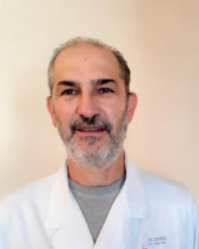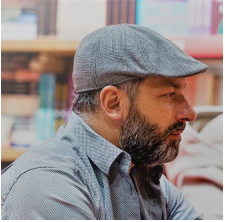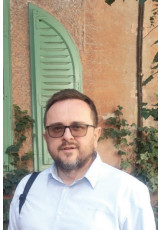Arben Dedja (Tirana, 1964) completed his studies at the Faculty of Medicine (1988) in his
hometown and later worked as a doctor in the province. In 1994 he specialized in surgery at the University Hospital of Tirana, where he worked for five years as a urologist. Since 1999 he has lived in Italy. At the University of Padua he received his doctorate with an
experimental study in neonatology and conducted research in the field of transplants, stem cells, heart valves, etc. He is currently a researcher in the Department of Cardio-Thoracic-Vascular Sciences and Public Health at the University of Padua.
In his alternative life, he has published three volumes of poetry and three of prose in Albania. For one of his books in prose he was awarded Author of the Year at the
17th Book Fair in Tirana (2014). In Italy he has published two volumes of poetry and two of prose, mostly including texts translated from Albanian, but also some work written directly in Italian. The last published title was Trattato di Medicina in 19 racconti e 1/2 (Vague Edizioni, Turin 2020).
Every February, during carnival, he emerges in one of the most picturesque, yet sombre costumes; dressed all in black, with a long cape falling below the ankles, right to the ground, so that he often balances on two crutches in order to seem even taller and even more menacing. On his head he wears a black, narrow-brimmed hat, tied below the chin with a (black) ribbon; his ears and neck are also covered by a black hood. The only white items are the ruff collar, frozen stiff with starch, and his gloves. And the mask, hiding his face, with two holes for the eyes, sometimes covered with dark glass, creating a murky, anxiety-inspiring impression, is in the shape of a vulture’s beak (with drawings on a relief of stylized flowers), a very large beak, arching down to the chest. Thus Venice casts a spell on an already metaphorical, perhaps somewhat pathetic character, but with great significance in its history: The Plague Doctor.
He was real back then. The drawings and descriptions of that time give us the full picture. He appeared as an apparition and destroyed the day: the shivers passed immediately to the sick (we cannot say whether the shivers resulted from the fever of the bedridden or from the approaching evil beak). The beak, filled with perfumes and spices to cover the stench of the dead, had two holes near the nostrils, enough to breathe. And it was this especially that terrified the unfortunate, a dark omen of an almost inevitable death. The whole scene took place in the so-called Ospedali degli Incurabili, a fatal, and ironic name.
And today? For years it seemed that pandemics passed us by or touched us only superficially, [1] except when this and other evenings remind us all of the past, like that shriveled grandmother by the fireplace who complains of aching joints as she remembers the pains of childbirth , and also the aches of her youth, old worries, and life itself.
Since long ago, when the plague entered Europe on Genoese ships returning from the Mongol siege of Caffa, on the Black Sea, in the first documented case of biological warfare, it was realized (then only intuitively) that an epidemic became global in direct proportion to the development of transport and free movement of people. After all, the epidemic is us, our individual actions, our social dynamics, along with the interaction of the pathogen with the human “host”. So it was with the plague which, beginning in the mid-fourteenth century, has been appearing intermittently around the world to this day (the last epidemic was recorded in Magadascar in 2017).
Immediately the disease began to progress inland at a rate estimated at 20 kilometres a week, reaching other Mediterranean ports even faster by sea. Of course, without access to treatment, mortality was extremely high: three-fifths of the residents of Florence died, says Villani, the Florentine chronicler. It was a truly “Malthusian” event. In total, Italy lost 30% of its population in the fourteenth century, and this continued: for example, in 1700 Italy had the same population as a hundred years before, in 1600.
The rich fled with their whole family to their second or third homes, in the villages, (contributing significantly to the spread of the disease, inluding to the neighbourhoods and towns spared by the first wave). Boccaccio describes the cessation and degradation of any activity, not only of economic trades, but also of the closest family relationships: parents who abandoned children or vice versa; priests who found excuses to avoid the anointing of those close to death.
The news that circulated fastest was false, confusing, unnecessary, sometimes even harmful, and as a result, terrified people reacted unreasonably. On the other hand, as soon as the “visibility” of the disease reduced, the population immediately demanded freedom of movement and trade. Riots broke out – a chaotic reaction by desperate and uninformed people – which quickly turned into revolts. These were not directed against the disease as such, nor against the famine that soon followed, but against the government, especially when it was apathetic, incapable of intervening, not to mention when it created the impression that it was taking advantage of the situation to make money. And so, the rulers vowed to do whatever they could, whether or not they achieved concrete results (populism?).
*
In contrast, the attitude towards doctors was ambiguous: while the ordinary people trusted more in charlatans, doctors took on capital importance for governments, even though they did not possess any particular weapon against the unknown disease. Nonetheless, the doctors, but also the pharmacists, and chemists, the “healers” of all types, did not give up, but paved the way for some of the most praised medications – I would not describe them as miraculous, rather as strange – in the whole history of medicine, for example, Theriaca Andromachi, [2] a panacea originally produced in the second century BC, and used by Nero’s court (Andromache was the emperor’s physician – and his name probably survived because of the courage he showed in giving this “medicine” to Nero himself). The Venetians dusted off the formerly glorious Theriaca presenting it as a miraculous treatment for the plague, monopolizing its production and distribution, and packaging it so cleverly that it remained in use until 1880.
The vast majority of doctors, however, lacked the courage for – what we would call – their main duty: to work at the bedside of the sick. Instead, they fled, together with the rich, using the excuse that they were following their clients, who were paying them. [3]
Once again, governments reacted. They began to centrally appoint Plague Doctors, who were responsible, among other duties, for reporting in writing the daily number of dead and infected. Also, in order to be able to understand the disease better, doctors were allowed to do what had previously been “taboo”: performing autopsies. Documents reveal, for example, that in Pavia (1479) a Giovanni de Ventura was offered immediate citizenship, an employment contract of thirty florins per month (a salary six times higher than the most skilled craftsman) and a well-equipped house on the condition that he did not demand additional compensation from the sick. It was similar in the Venetian Senate: they forced doctors to treat anyone, regardless of financial status. Out of the eighteen Plague Physicians registered by the lagoon authorities in 1348, five died and twelve fled in fear (of the disease). On the other hand, we learn that the Senate decorated a Dr. Francisco (from Rome), who diligently served the community.
*
Thus came into play the will of the state, which, however limited (we are dealing with mini-states or city-states – republics, duchies – but rich and with rapid decision-making), can be seen as the origin of the universal health service, that that we seek to enjoy today. It was understood that the human ability to control the epidemic was closely linked to the existence of efficient institutions, in particular public health authorities capable of coordinating at various local and state levels (today we would say: planetary). The commissions set up were called Pro conservatione sanitatis (1348). They dealt with the strict control of any movement thought capable of spreading the disease, the (military) control of border points, seaports and rivers (first level). When the infectious agent passed this cordon, the second level health cordon was implemented, involving the cleaning of the city (removal of garbage, drainage of wells, and the burning of clothes and bedding of the dead); finally, in the third level, in order to slow down (if not stop) the spread within communities, contact between people was restricted through quarantine[4] or other restrictions on the freedom of movement. It was the epidemic that forced governments to take an interest in and care for the poor and the forgotten. Thus the beggars and the homeless were locked up in buildings dedicated to them or, in case of resistence, they were expelled (with public money). The sick were isolated in certain buildings, at some distance from residential areas. The first of these was erected in Venice in 1423, on an uninhabited 2.5-hectare island near Lido: Santa Maria di Nazareth, which as a result of linguistic distortions became known as Lazzaretto worldwide. As soon as this became possible (the human mind is always plagued by doubt) the question arose: what to do about those who we cannot say for sure are infected or not. Is it a crime to put them together with the infected? No sooner was it said than it was done: another uninhabited island of the lagoon was specially equipped for the “suspects” who might have the plague (in 1468, Lazzaretto Nuovo).
For these efforts to be effective, more sophisticated coordination between states was necessary, for which there is documented evidence. Thus, in Italy in the seventeenth century, the commissions were transformed by law into permanent institutions called: Permanent Health Commissions. If we want to draw a straight line, we can argue that the World Health Organization today has evolved from these ancestors.
*
Today the statements about the epidemic in the press and on social networks by a wide range of doctors, prominent in their field, have to be filtered to some extent. But why is it that even doctors, in their statements, end up contradicting one another?
Firstly because – and this is less intuitive – medicine is not an exact science. Indeed, medicine sits somewhere between humanities and genuine scientific knowledge. There is always subjectivism, as long as its object is man. More than science, medicine is a “practice” that improves by trial-and-error, and when the disease is new, and unknown, it takes time for the doctor to try harder and make fewer errors.
A second reason is that medical science (let me call it science anyway) is, to this day, so vast and varied that specialisations and sub-specialisations can no longer understand each other. Of course, if you talk to an intensive care specialist, they can give you a detailed explanation about treatment in the intensive care unit, about the cocktails of drugs (apologies for the bartender language, but the intensive care specialists – believe me – like this word too) they use depending on the patient, but, at the moment when the tired journalist, disoriented by the overwhelming number of specialisations, or simply unable to immediately find another doctor to ask, expands the range of questions about the disease, then from the mouth of this brilliant intensive care specialist we may hear some inaccuracies, simply because it is not their area of expertise. This is why one should talk to the epidemiologist regarding the manner of spread of the disease in the population and the interpretation of the graphs of the affected and the cured, in time and space; one should talk to the virologist about the mode of transmission, distances, protection of personnel or each one of us, and the effects on the body; whereas for vaccines, the immunity of the population, the long-term memory of the cells in maintaining this immunity, one needs the immunologist.
*
Think about equations. Often we solve – by simplifying, thanks to laws and formulas – the left hand side of an equation to arrive at an equalisation, not only factual but also visual, with the other side. This is what I did: drawing on a former epidemic, I mentioned events, decisions, and human behavior (left hand side), so that the reader’s mind can automatically make a comparison with the situation we are experiencing (right hand side). Hundreds of years have passed, but it is clear that the instinctive reaction, the psychology, the anxiety, the fear – so difficult to control – that fluctuates and moves, turning into a terrible flood of doubts, into collective psychosis, has not changed, nor have the reasons – sometimes wise, often not – about what is happening to (in) the humanity. Man is a very young social being not to react just as he did back then. He is also a very new biological being – two million years old – compared to the virus, an organism[5] that has existed for three hundred and fifty million years. Thus, perhaps, at first the virus finds it easy to gain ground with its ancient cruelty. Thus, perhaps, in the beginning, the only weapons we possess to fight it are the old ones, like the virus: physical distancing, hand washing, and few other things. Until our cooperation and intelligence produces various vaccines and medicines, and few other things.
*
As I wrote the text, I’m sure you will have noticed, I did not mention the name of our current pandemic anywhere. I circled around it, I referred to it; I saw its long shadow in the light of others, those who have passed away forever; I did this like that primitive man: superstitious and mysterious, who strives to smile a little at the carnival of life.
Translated by Alexandra Channer
[1] In fact, they have never been separated from man. To give an example: since June 5, 1981 AIDS continues (officially), which so far (note the figures!) has caused 32.7 million deaths. There are currently 38 million seropositives in the world, 1.8 million of whom are children.
[2] Some of its sixty-two “secret” ingredients included: opium, cinnamon, wine, dried peppermint powder, mummification powder, etc.
[3] The Hippocratic oath and the doctor in the service of even the poorest is a much later romanticism.
[4] In accordance with the doctrine of Hippocrates, according to which an acute illness, such as the plague, appeared within a maximum of forty days. Hence the term.
[5] Up to the present, about 5,000 viruses have been identified, but millions are thought to exist: it is the most abundant biological entity on the planet. An obligate parasite – it replicates only inside the cells of any life form: animal, plant, microbe, or another virus. Outside the organism are independent and inactive particles (virions) – hence they are called living-non-living organisms (on the edge of life). They have no cellular structure, nor metabolism. Inside the cell they are no longer individual: nucleic acids and their by-products take control of part of the cellular biosynthetic activity to produce new virions. They have a genome divided into segments giving it the ability to recombine when several viral variants have infected the same cell. Separately, viral diseases are not fixed entities – they differ diachronically, firstly due to small mutations to the genome (antigenic drift), and secondly, due to a major antigenic change (antigenic shift), which results in profound transformation. We, in the human genome have integrated many viruses in the past (after integrating into the germ line), many of them already extinct.







